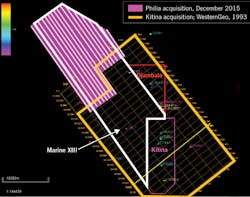Tayvis Dunnahoe
Exploration Editor
Shooting new 3D seismic and reprocessing legacy data offshore Congo (Brazaville) will lead to near-term exploration despite an overall decline in exploration worldwide as the industry works toward oil-price stability.
Congo's Marine XIII block lies 50 km offshore in water 100-500 m deep. Prospects mapped in its southern part are 2-6 km west of the Eni SPA-operated Kitina Marine oil field (Fig. 1). The central part of the block holds additional prospects 0.5-7.0 km west of the Djambala North and Djambala South oil fields, also operated by Eni. Prospects in the northern part are less than 10 km west of the Total SA operated Libondo Marine oil field.
Geneva-based exploration firm Philia owns the Marine XIII block, the operator's first upstream project in the Republic of Congo. Philia acquired the block via a farm-out in October 2013 and holds 85% interest as operator, with Congolese state-owned Societe Nationale des Petroles du Congo (SNPC) as its sole partner with 15% interest.
"Congo is particularly interesting for Philia because of its remaining attractive exploration potential in the upstream sector," said Stefano Rossi, the company's director of exploration. "It is a prospective oil and gas sector that we are committed to developing and expanding economically and socially," he said.
Shooting presalt
The company completed its first work on Marine XIII in March 2015, reprocessing existing 3D seismic data of the block's southern portion. In December 2015, Philia shot 350 sq km of new 3D seismic on Marine XIII's northern portion (Fig. 2). Seismic acquisition lasted 18 days and included 26 sail lines. Data processing will be completed by July 2016.
Polarcus France SAS conducted Philia's survey using the vessel Polarcus Alima. The survey acquired 236 sq km of full-fold migrated data with the objective of performing a precise interpretation of prospective hydrocarbon plays in the presalt and post-salt sequences of the Congo basin.
Seismic data were acquired with large-volume air guns and long-offset, deep-towed solid streamers to improve subsurface images in the deep presalt sequence. Further application of advanced deghosting techniques broadened the data spectrum.
Imaging of the presalt sequence will apply anisotropic prestack tomographic velocity modeling and depth migration algorithms to the broadened seismic data. According to Rossi, "This prospecting strategy improves the rate of penetration and focuses the seismic energy on presalt sequences to an unprecedented level." The processed seismic data for Marine XIII will provide the operator a full view of the deep basement formation. These improvements in presalt seismic imaging clarity should derisk the operator's exploration activities offshore Congo.
Short-term exploration
Prospects in the block are all close to producing oil fields. Libondo opened in 2008 (OGJ Online, May 7, 2009), and Kitina Marine and Djambala fields were established in 1997 and 2000 respectively.
Production in these nearby fields lends credibility to exploration drilling in the Marine XIII block where exploration targets will be confirmed by the interpretation of new seismic data. "Drilling of our first well is foreseen in the short term, however, this also depends on the impact of the current oil price," Rossi said.
Philia is working to both secure contractual conditions better suited to the current price environment and develop future operations for execution once prices rise.
